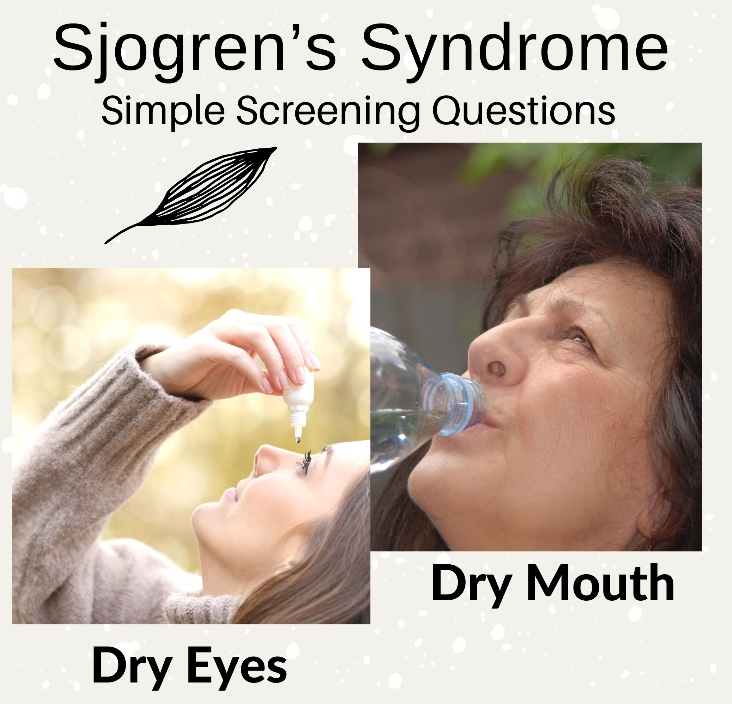Sjogren's Syndrome: Easy to Screen But Just as Easy to Forget
Sjogren’s Syndrome: Remembering to Ask about Dryness
Dry mouth and dry eyes are common in the population. They are also frequent symptoms of Sjögren’s syndrome (SS). Not every patient with dry mouth and/or dry eyes has Sjögren’s syndrome. However, unless the diagnosis crosses the mind of the hair specialist evaluating the patient in front of them - the diagnosis may continue to remain hidden. Many people have Sjogren’s and don’t know it.
See prior article Sjogren's Syndrome: What does the hair specialist need to know?
Sjögren’s syndrome is a complex disorder. About 1 in 200 people have the condition although the true prevalence may be higher. The most common age of diagnosis is betweein 40 and 60 and the average age is around 52 years. Women are more commonly affected than men and the F:M ratio is 9:1. Sjögren’s is called “primary” when no other autoimmune diseases are present and “secondary” when other autoimmune diseases (like lupus or rheumatoid arthritis) are present.
There are many reasons for dry eyes and dry mouth. Sjogren’s syndrome may be one of them.
Most patients with Sjögren’s syndrome have dry mouth and dry eyes. Prior studies estimated dry mouth in 93.5-98 % of affected patients with SS and dry mouth in 67-93%. The symptoms may not develop at the same time and one may come before the other. Some with SS however do not have these symptoms at all.
But Sjögren’s is far more than a condition or dry mouth and dry eyes. It may affect many organ systems including nervous system (neuorpathy), joints (arthritis), lungs (interstitial lung disease), kidneys (glomerulonephritis). An increased risk of lymphoma is now understood to occur in patients with Sjögren’s syndrome.
Dry Mouth Symptoms in Sjogren’s
Dry mouth in SS is usually more than mild dry mouth. Patients need water to swallow food during meals. It is impossible for many to eat a cracker. Many wake up repeatedly at night to drink water many times. Many have increased cavities and may experience oral candidiasis (thrush).
Dry Eye Symptoms in Sjogren’s
Patients describe a variety of eye symptoms including itching, grittiness, soreness, dryness. Often the eyes have a normal appearance. Many patients turn to use of over the counter eye drops even before a diagnosis. Patients may have photosensitivity, redness, eye fatigue, and may report a sensation that they have a film across the eyes. Low humidity and smoking will exacerbate symptoms. Consultations with ophthalmology are needed. Corneal ulcerations, vascularization and even perforation can occur. -
Asking about Dry Mouth and Dry Eyes in Routine Practice
It is important for the hair specialist to routinely inquire about dry mouth and dry eyes as part of general screening of any patient. When I ask about sleep, I always ask if patients wake up throughout the night to drink water. I ask about difficulties in eating and whether they are being diagnosed with more and more dental cavities in recent years. I ask about eye symptoms of itching, dryness, grittness, redness and whether they need eye drops. These screening questions may allow patients to be referred to rheumatologists for proper assessment and for SS to ultimately be diagnosed earlier and further investigations to be undertaken. Such tests are essential to see if there are other organ systems involved. It can take some patients up to 10 years to get a proper diagnosis so being on alert for SS can dramatically alter the course of people’s lives.
For Further reading, please see
Donovan, J. Sjogren's Syndrome: What does the hair specialist need to know?
This article was written by Dr. Jeff Donovan, a Canadian and US board certified dermatologist specializing exclusively in hair loss.

